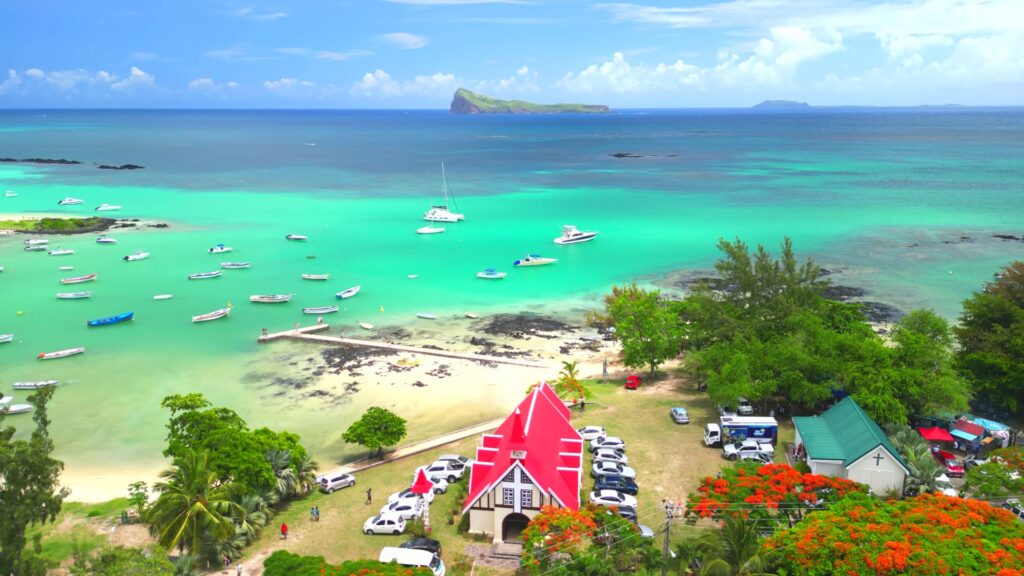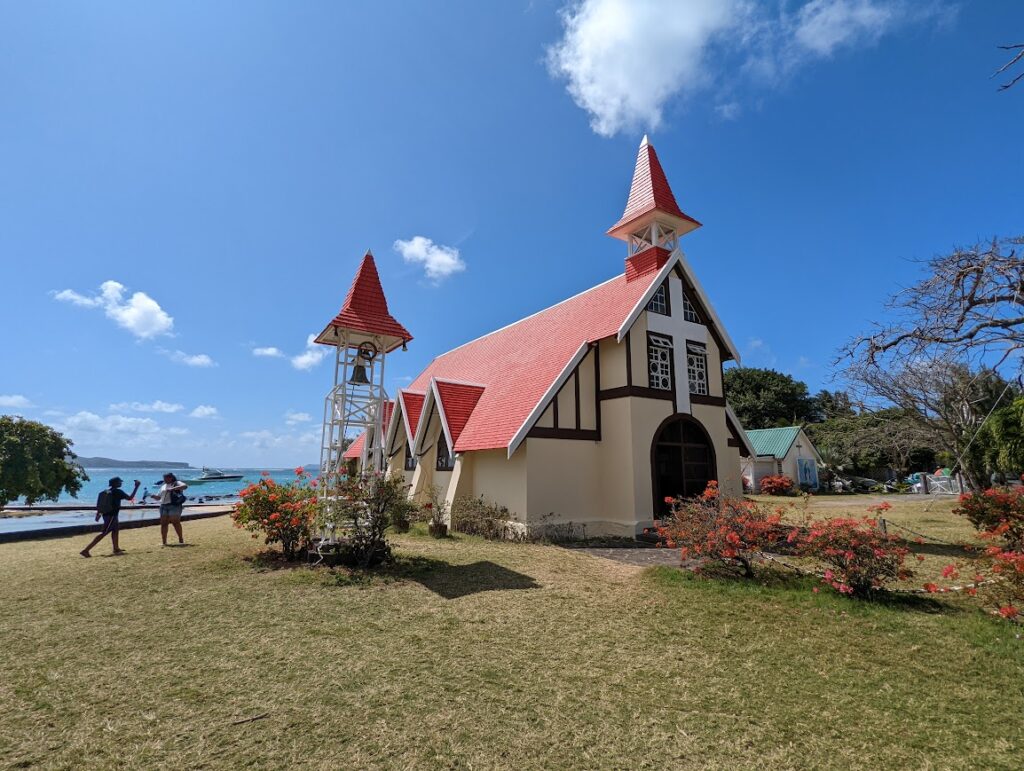Just north of Grand Baie, at the very tip of Mauritius, there’s a little red-roofed church that catches your eye long before you arrive. Notre-Dame Auxiliatrice de Cap Malheureux stands quietly by the sea, framed by palm fronds and a shimmering turquoise lagoon. It’s one of those places that doesn’t need words or signs to explain its magic. You see it, and you know it’s special.
I first came here early one morning, just after sunrise. The sky was soft and pale. Fishermen were already back onshore, their boats rocking gently in the shallows while they sorted nets and stories from the night before. Then I saw the church, glowing warm against the coolness of the morning. A simple chapel, small and elegant, with a scarlet roof that looks painted straight from a dream.
A red roof with a story behind it
Locals call it “the red-roof church” but its full name is Notre-Dame Auxiliatrice de Cap Malheureux. The name might sound formal, but the feeling of the place is the exact opposite. It was built in 1938 for the fishing community, designed by Mauritian artist Max Boullé. He blended island practicality with European lines. The result is something that feels both sacred and deeply local.
What really struck me was how much life this chapel holds. It’s still used every Sunday for Mass, and even on weekdays, you’ll find someone lighting a candle or just sitting inside, letting the quiet settle in. The holy water is held in a giant seashell. Not a replica, a real one. The kind of thing you’d expect to see deep under the ocean, not tucked into a church wall. That detail stays with you.
Cap Malheureux itself, whose name translates to “Unlucky Cape”, carries a history of shipwrecks and colonial shifts. It was here in 1810 that the British landed and claimed the island from the French. Somehow, the church seems to hold all that memory, yet still offers something calm and forgiving. There’s no heaviness, just a breeze that lifts the prayer flags and moves gently through the doors.

A postcard with purpose
It’s no secret that Notre-Dame Auxiliatrice de Cap Malheureux is one of the most photographed places in Mauritius. And honestly, it earns it. The composition is perfect. Bright roof, cream walls, a backdrop of Coin de Mire rising like a watchful guardian out at sea. But it’s not just a pretty face. There’s something deeper, something rooted in the way it belongs to the people here.
On the feast day of Mary Help of Christians, the area comes alive with songs, processions, and children in white dresses walking barefoot in the sand. It’s beautiful, emotional, and somehow still unforced. A real part of the island’s rhythm. Weddings happen here too. Not the over-the-top destination kind. More the quiet, heartfelt ones, with wind in your hair and bare feet on the grass.
If you’re planning to visit, go early in the day. The light is softest then, and you might have the place almost to yourself. Bring a sarong to cover your shoulders. Step inside and let the stillness settle in. Then, when you’re done, walk down to the rocks and look out toward the reef. The colours are different every time.
Before you leave Cap Malheureux, there’s one more place I always stop. Just a few steps from the chapel, tucked under a huge tree beside the beach, is Lakaz Sandrine. It’s the kind of spot that doesn’t try too hard. No polished signs, no loud music. Just the smell of charcoal, the sound of the sea, and the promise of the best seafood BBQ on the island. You can sit at a plastic table right in the sand, shaded by leaves, and order grilled lobsters, fresh fish, or giant prawns straight from the fire. Everything is simple, fresh, and unforgettable. It’s local food at its best, made by people who care about flavour more than presentation.
There’s no ticket booth or guided tour here. Just a church that has stood through storms, celebrations, and quiet days alike. Whether you come for the view or for something deeper, Notre-Dame Auxiliatrice de Cap Malheureux gives you space to breathe. And that, in the end, might be the real reason it stays in people’s hearts.



